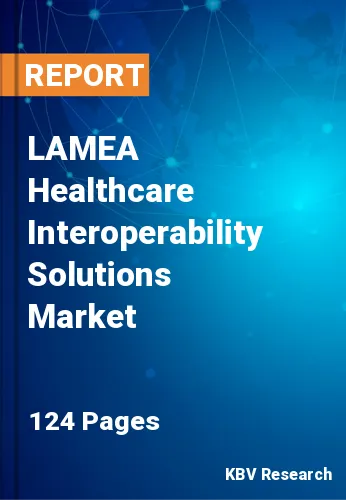The Latin America, Middle East and Africa Healthcare Interoperability Solutions Market would witness market growth of 17.9% CAGR during the forecast period (2023-2029).
The market for healthcare interoperability solutions is predicted to increase as more healthcare providers adopt and invest in digital healthcare solutions and as concerns regarding escalating healthcare expenses grow. A few of the primary advantages of implementing healthcare interoperability solutions include, among other things, a rise in healthcare productivity, an improvement in the standard of care and patient experience, a drop-in healthcare costs, and a reduction in physician burnout.
As a result, investments in healthcare IT & interoperability solutions are anticipated to rise throughout the forecast period, which is anticipated to spur the market for such solutions to develop. Additionally, one of the main concerns for governments is the rising cost of healthcare worldwide. To address this, healthcare IT solutions are being adopted and deployed, which is further anticipated to increase the adoption of healthcare interoperability solutions as they will be essential in transferring data between different locations.
The UAE market is anticipated to expand due to the rising demand for internet-based patient care and healthcare services. Due to the growing use of artificial intelligence (AI), the Internet of Things (IoT), and rising customer demand for cloud-based healthcare services, the market in the UAE will keep growing. Patients seeking advice from physicians regarding preventive measures against COVID-19 and seeking consultations on other medical conditions contributed to the expansion of the regional market in the years to come. As internet usage rises, there is potential for growth because more individuals are using it and are more inclined to look for alternative viewpoints and medical guidance online using web-based resources and mobile applications.
The Brazil market dominated the LAMEA Healthcare Interoperability Solutions Market by Country in 2022, and would continue to be a dominant market till 2029; thereby, achieving a market value of $140 million by 2029. The Argentina market is experiencing a CAGR of 18.6% during (2023 - 2029). Additionally, The UAE market would display a CAGR of 17.6% during (2023 - 2029).
Based on End User, the market is segmented into Healthcare Providers (Hospitals & Clinics, Long-term Care Centers, Diagnostic & Imaging Centers and Others), Healthcare Payers and Pharmacies. Based on level of Interoperability, the market is segmented into Structural, Foundational and Semantic. Based on Type, the market is segmented into Services and Software (EHR interoperability solutions, Lab system interoperability solutions, Imaging system interoperability solutions, Enterprise interoperability solutions, Healthcare information exchange interoperability solutions and Others). Based on countries, the market is segmented into Brazil, Argentina, UAE, Saudi Arabia, South Africa, Nigeria, and Rest of LAMEA.
Free Valuable Insights: The Worldwide Healthcare Interoperability Solutions Market is Projected to reach USD 7.5 Billion by 2029, at a CAGR of 12.9%
The market research report covers the analysis of key stakeholders of the market. Key companies profiled in the report include Oracle Corporation (Cerner Corporation), Epic Systems Corporation, Virtusa Corporation, Wipro Limited, Koninklijke Philips N.V., Veradigm, Inc., Cognizant Technology Solutions Corporation, Onyx technology LLC, Orion Health Group Limited, and InterSystems Corporation.
By End User
By level of Interoperability
By Type
By Country
Our team of dedicated experts can provide you with attractive expansion opportunities for your business.

